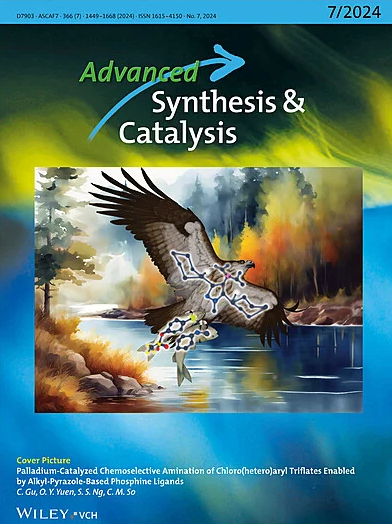高效二氧化碳固定磷酸烯醇丙酮酸羧化酶的研究进展
IF 4
2区 化学
Q2 CHEMISTRY, APPLIED
引用次数: 0
摘要
从环境中提取多余的CO2需要良好的固碳方法,其中生物炭固碳是最有效的方法之一。因此,开发高效磷酸烯醇丙酮酸羧化酶(PEPC)以满足生物固碳对高效固碳和增强代谢通量日益增长的需求具有重要意义。在这项研究中,从大麻中鉴定了一个高活性的PEPC (CsPEPC)。然而,该酶表现出较差的热稳定性,在50°C时半衰期仅为13分钟。为了提高CsPEPC的性能,包括分子动力学、FoldX能量计算和基于PROSS的预测在内的多种策略被整合到筛选有益的变体中。由此产生的突变体CsPEPCC886R的活性增加了两倍(在50°C时为249.2 U mg-1),稳定性提高了五倍。此外,添加25%的甘油作为蛋白质稳定剂,显著延长了CsPEPCC886R的半衰期31倍,最终将半衰期提高到2178分钟。体外生产实验表明,最佳突变体CsPEPCC886R在270分钟内产生116.8 mM草酰乙酸。这项工作为生物二氧化碳固定提供了一个有希望的PEPC变体,它具有改善碳同化的巨大潜力,并支持高效,碳中性生物合成途径。本文章由计算机程序翻译,如有差异,请以英文原文为准。

Engineering Phosphoenolpyruvate Carboxylase with Improved Activity and Stability for High‐Efficiency Carbon Dioxide Fixation
The extraction of excess CO2 from the environment requires favorable carbon sequestration methods, among which biochar sequestration is one of the most effective approaches. Therefore, to meet the growing demand for high‐efficiency carbon fixation and enhanced metabolic flux in biological carbon sequestration, the development of high‐performance phosphoenolpyruvate carboxylase (PEPC) is of significant importance. In this study, a high‐activity PEPC from Cannabis sativa (CsPEPC) is identified. However, the enzyme exhibits poor thermal stability, with a half‐life of only 13 min at 50 °C. To improve CsPEPC performance, diverse strategies, including molecular dynamics, FoldX energy calculations, and PROSS‐based prediction, are integrated to screen beneficial variants. The resulting mutant CsPEPCC886R shows a twofold increase in activity (249.2 U mg–1 at 50 °C) and fivefold greater stability. Furthermore, the addition of 25% glycerol as a protein stabilizer significantly extends the half‐life of CsPEPCC886R by 31‐fold, ultimately increasing the half‐life to 2178 min. In vitro production experiments show that the optimal mutant CsPEPCC886R generates 116.8 mM oxaloacetate within 270 min. This work provides a promising PEPC variant for biological CO2 fixation, which holds great potential for improving carbon assimilation and supports the development of efficient, carbon‐neutral biosynthetic pathways.
求助全文
通过发布文献求助,成功后即可免费获取论文全文。
去求助
来源期刊

Advanced Synthesis & Catalysis
化学-应用化学
CiteScore
9.40
自引率
7.40%
发文量
447
审稿时长
1.8 months
期刊介绍:
Advanced Synthesis & Catalysis (ASC) is the leading primary journal in organic, organometallic, and applied chemistry.
The high impact of ASC can be attributed to the unique focus of the journal, which publishes exciting new results from academic and industrial labs on efficient, practical, and environmentally friendly organic synthesis. While homogeneous, heterogeneous, organic, and enzyme catalysis are key technologies to achieve green synthesis, significant contributions to the same goal by synthesis design, reaction techniques, flow chemistry, and continuous processing, multiphase catalysis, green solvents, catalyst immobilization, and recycling, separation science, and process development are also featured in ASC. The Aims and Scope can be found in the Notice to Authors or on the first page of the table of contents in every issue.
 求助内容:
求助内容: 应助结果提醒方式:
应助结果提醒方式:


